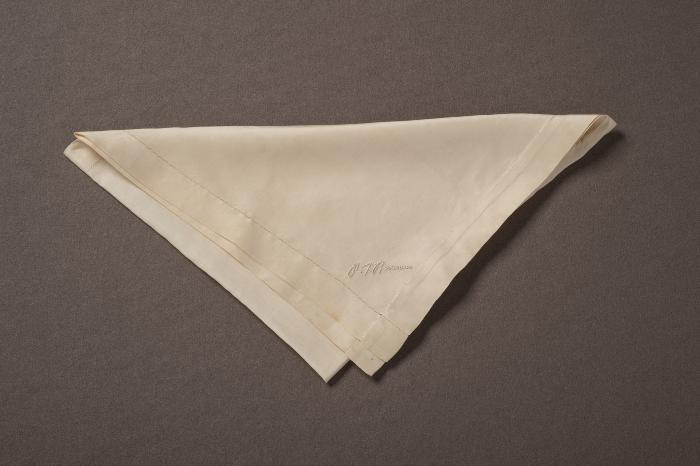Clothing accessory: Handkerchief with P. T. Barnum signature
1880 – 1890 (Date manufactured/created)
Textile/Personal Artifact
22 in H
X
23 1/5 in W
Silk handkerchief with embroidered signature of P. T. Barnum. This cream color handkerchief is made of a finely woven silk, very smooth to the touch, with a hem-stitched border. P. T. Barnum's signature is embroidered in matching silk thread across one corner of the handkerchief. Before paper facial tissues (like Kleenex brand) came into use, people carried cloth handkerchiefs, which could be made of cotton, linen of varying fineness, or silk. In addition being functional, handkerchiefs were also status indicator accessories, since the quality of the material and stitching revealed what a person could afford to purchase. Normally handkerchiefs were marked with the owner's initials to identify them in laundry. A fancy embroidered monogram was a step up from simple marking. Barnum's handkerchief is unusual in that it features his famous signature. The Barnum Museum also owns another of P. T. Barnum's handkerchiefs, which features a large monogram of entwined letters embroidered in light red, light brown and off white.
Phineas Taylor Barnum was born on July 5, 1810 in Bethel, Connecticut. Over the course of his life he had many careers, although he is best known today for the Barnum & Bailey Greatest Show on Earth. In the 1840s he achieved international fame through his American Museum in New York City, and by promoting and touring performers, notably "General Tom Thumb," and Swedish soprano Jenny Lind. His began his circus ventures when he was in his early 60s. The first of these, in the early 1870s, was called P. T. Barnum’s Grand Traveling Museum, Menagerie, Caravan and Circus. Barnum subsequently opened the New York Hippodrome with similar acts. In the 1880s, competition from other circuses increased. A merger between Barnum’s show and the Great London Show of Cooper, Bailey, and Hutchinson formed the circus called Barnum and London. Barnum's partnership with James A. Bailey in 1887 formed Barnum & Bailey, which continued to be managed by Bailey after Barnum's death in 1891. Barnum is buried in his adopted city of Bridgeport, Connecticut, in Mountain Grove Cemetery.
Phineas Taylor Barnum was born on July 5, 1810 in Bethel, Connecticut. Over the course of his life he had many careers, although he is best known today for the Barnum & Bailey Greatest Show on Earth. In the 1840s he achieved international fame through his American Museum in New York City, and by promoting and touring performers, notably "General Tom Thumb," and Swedish soprano Jenny Lind. His began his circus ventures when he was in his early 60s. The first of these, in the early 1870s, was called P. T. Barnum’s Grand Traveling Museum, Menagerie, Caravan and Circus. Barnum subsequently opened the New York Hippodrome with similar acts. In the 1880s, competition from other circuses increased. A merger between Barnum’s show and the Great London Show of Cooper, Bailey, and Hutchinson formed the circus called Barnum and London. Barnum's partnership with James A. Bailey in 1887 formed Barnum & Bailey, which continued to be managed by Bailey after Barnum's death in 1891. Barnum is buried in his adopted city of Bridgeport, Connecticut, in Mountain Grove Cemetery.
Possibly transfer from Discovery Museum? Originally loaned to them by Mrs. Alvin C. Breul
T 2014.001.001
